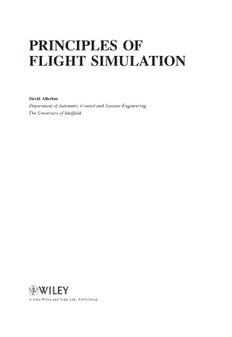Table Of ContentPRINCIPLES OF
FLIGHT SIMULATION
David Allerton
DepartmentofAutomatic Controland SystemsEngineering
TheUniversityofSheffield
A John Wiley and Sons, Ltd., Publication
PRINCIPLES OF
FLIGHT SIMULATION
Aerospace Series List
Handbook of Space Technology Ley, Wittmann April 2009
& Hallmann
Surrogate Modelling in Engineering Forrester, Sobester August 2008
Design: A Practical Guide & Keane
Aircraft Performance Theory and Swatton August 2008
Practice for Pilots
Aircraft Systems, 3rd Edition Moir& Seabridge
Introduction to Aircraft Aeroelasticity Wright & Cooper December 2007
and Loads
Stability and Control of Aircraft Systems Langton September 2006
Military AvionicsSystems Moir& Seabridge February 2006
Design and Development of Aircraft Moir& Seabridge June2004
Systems
Aircraft Loading and Structural Layout Howe May 2004
Aircraft Display Systems Jukes December 2003
Civil AvionicsSystems Moir& Seabridge December 2002
PRINCIPLES OF
FLIGHT SIMULATION
David Allerton
DepartmentofAutomatic Controland SystemsEngineering
TheUniversityofSheffield
A John Wiley and Sons, Ltd., Publication
Thiseditionfirstpublished2009
2009,JohnWiley&Sons,Ltd
Registeredoffice
JohnWiley&SonsLtd,TheAtrium,SouthernGate,Chichester,WestSussex,PO198SQ,UnitedKingdom
For details of our global editorial offices, for customer services and for information about how to apply for
permissiontoreusethecopyrightmaterialinthisbookpleaseseeourwebsiteatwww.wiley.com.
The right of the author to be identified as the author of this work has been asserted in accordance with the
Copyright,DesignsandPatentsAct1988.
Allrightsreserved.Nopartofthispublicationmaybereproduced,storedinaretrievalsystem,ortransmitted,in
anyformorbyanymeans,electronic,mechanical,photocopying,recordingorotherwise,exceptaspermittedby
theUKCopyright,DesignsandPatentsAct1988,withoutthepriorpermissionofthepublisher.
Wileyalsopublishesitsbooks inavarietyofelectronic formats.Somecontentthatappearsinprintmaynotbe
availableinelectronicbooks.
Designations usedby companies todistinguish theirproducts areoften claimedas trademarks. All brand names
and product names used in this book are trade names, service marks, trademarks or registered trademarks of
theirrespectiveowners.Thepublisherisnotassociatedwithanyproductorvendormentionedinthisbook.This
publicationisdesignedtoprovideaccurateandauthoritativeinformationinregardtothesubjectmattercovered.
Itissoldontheunderstandingthatthepublisherisnotengagedinrenderingprofessionalservices.Ifprofessional
adviceorotherexpertassistanceisrequired,theservicesofacompetentprofessionalshouldbesought.
AcataloguerecordforthisbookisavailablefromtheBritishLibrary.
ISBN:978-0-470-75436-8(Hbk)
Typesetin10/12TimesbyLaserwordsPrivateLimited,Chennai,India
PrintedandboundinGreatBritainbyAntonyRoweLtd,Chippenham,Wiltshire
For Clare, Fergus and Patrick – the best team I ever played for.
Contents
About the Author xiii
Preface xv
Glossary xvii
1 Introduction 1
1.1 Historical Perspective 1
1.1.1 TheFirst40YearsofFlight1905–1945 1
1.1.2 AnalogueComputing,1945–1965 3
1.1.3 DigitalComputing,1965–1985 5
1.1.4 TheMicroelectronicsRevolution,1985–present 6
1.2 The Case for Simulation 9
1.2.1 Safety 9
1.2.2 FinancialBenefits 10
1.2.3 TrainingTransfer 11
1.2.4 EngineeringFlightSimulation 13
1.3 The Changing Role of Simulation 14
1.4 The Organization of a Flight Simulator 16
1.4.1 EquationsofMotion 16
1.4.2 AerodynamicModel 17
1.4.3 EngineModel 18
1.4.4 DataAcquisition 18
1.4.5 GearModel 19
1.4.6 WeatherModel 19
1.4.7 VisualSystem 20
1.4.8 SoundSystem 21
1.4.9 MotionSystem 21
1.4.10 ControlLoading 22
1.4.11 InstrumentDisplays 23
1.4.12 NavigationSystems 23
1.4.13 Maintenance 24
1.5 The Concept of Real-time Simulation 24
1.6 Pilot Cues 27
1.6.1 VisualCueing 28
1.6.2 MotionCueing 29
1.7 Training versus Simulation 30
1.8 Examples of Simulation 32
1.8.1 CommercialFlightTraining 32
viii Contents
1.8.2 MilitaryFlightTraining 34
1.8.3 AbInitioFlightTraining 34
1.8.4 LandVehicleSimulators 34
1.8.5 EngineeringFlightSimulators 35
1.8.6 AptitudeTesting 36
1.8.7 Computer-basedTraining 36
1.8.8 MaintenanceTraining 37
References 37
2 Principles of Modelling 41
2.1 ModellingConcepts 41
2.2 Newtonian Mechanics 43
2.3 Axes Systems 51
2.4 Differential Equations 53
2.5 Numerical Integration 56
2.5.1 ApproximationMethods 56
2.5.2 First-orderMethods 58
2.5.3 Higher-orderMethods 59
2.6 Real-time Computing 63
2.7 Data Acquisition 67
2.7.1 DataTransmission 67
2.7.2 DataAcquisition 69
2.8 Flight Data 74
2.9 Interpolation 77
2.10 DistributedSystems 82
2.11 A Real-time Protocol 91
2.12 Problems in Modelling 92
References 96
3 Aircraft Dynamics 97
3.1 Principles of Flight Modelling 97
3.2 The Atmosphere 98
3.3 Forces 100
3.3.1 AerodynamicLift 100
3.3.2 AerodynamicSideforce 104
3.3.3 AerodynamicDrag 105
3.3.4 PropulsiveForces 106
3.3.5 GravitationalForce 107
3.4 Moments 107
3.4.1 StaticStability 109
3.4.2 AerodynamicMoments 111
3.4.3 AerodynamicDerivatives 113
3.5 Axes Systems 114
3.5.1 TheBodyFrame 115
3.5.2 StabilityAxes 117
3.5.3 WindAxes 117
3.5.4 InertialAxes 118
3.5.5 TransformationbetweenAxes 118
3.5.6 Earth-centredEarth-fixed(ECEF)Frame 119
3.5.7 LatitudeandLongitude 122
3.6 Quaternions 122

